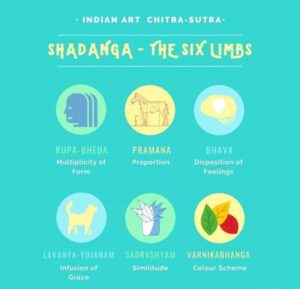The Six Limbs of Indian Art

Art Theory! Chitra-sutra (part of Vishnudharmottara Purana) was once an oral tradition, then recorded on paper around the fifth century C.E., and is the oldest known treatise on painting in the world.
The ‘Shadanga’ or Six Limbs of Indian Painting, appearing in the third khanda of Chitra-sutra, are a series of canons laying down the main principles of art. The subsequent development of painting by the Buddhists indicates that these ‘Six Limbs’ were put into practice by Indian painters and are the basic principles on which Indian art was founded.
Here’s a graphic ready reckoner on the Shandanga – further reading is highly recommended!

Rupa-Bheda – Multiplicity of form and the knowledge of appearances
Pramana – Correct perception, measure and structure,
Bhava – Action of feelings on forms,
Lavanya-Yojanam – Infusion of grace, artistic representation,
Sadrashyam – Similitude, has a reference to how faithful a picture is to the original,
Varnikabhanga – Artistic manner of using the brush and colours.
